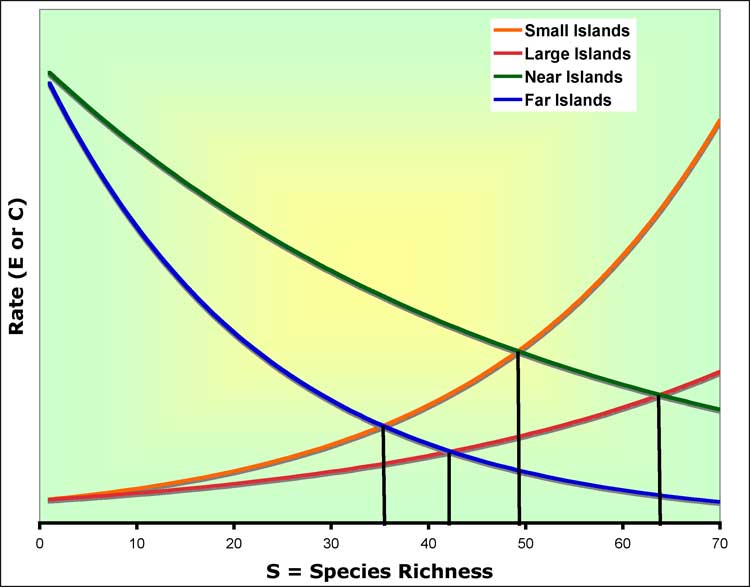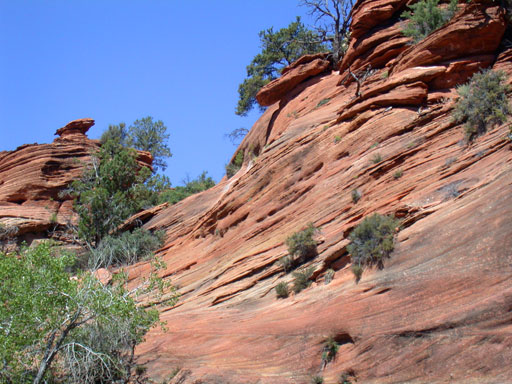| |
BIOL
4120
Principles of Ecology
Phil Ganter
320 Harned
Hall
963-5782
|
| Sedimentary
Rock in Zion National Park |
Lecture 19 Landscape Ecology
Email me
Back to:
Overview
- Link to Course Objectives
Landscapes
- A Landscape is mosaic of environmental
Patches considered together
- Each patch is embedded in
a matrix of surrounding
patches that differ in some significant way from the patch under consideration
- Patches are (relatively)
homogeneous within and differ from thier neighbors
- Patch edges can be
- Inherent
Edges - those set by natural geographic features
- Inherent edges are more
or less permanent, as least as long as the geographic feature is permanent
- Induced Edges
- those that have been created by disturbance (fire, flood, etc.)
- Induced edges are usually temporary unless
the underlying geography has been changed by the disturbance
- Patches for plants are defined
by physical characteristics such as soil type, moisture, etc.
- Where patches meet, Borders
are formed
- Borders can be
- Narrow
or Wide
- Wide borders become
habitats of their own and are referred to as Ecotones,
transition zones between adjacent patches
- Ecotones are places
where hybrids between species characteristic of the adjacent patches
are found
- Classic example comes
from wild iris species - one species found in wet soils next to
streams and another found in dry soils in the forest with the
hybrid found in a zone between forest and stream with soils intermittantly
dry and wet
- Straight
or Convoluted
- Sealed
or Perforated
- Sealed and perforated
refer to the ease with which organisms move from patch to patch
and so this quality will depend not only on the physical characteristics
of the patch but the characteristics of the species being considered.
A sealed border for some species may be perforated for others.
- Edges have different conditions
than do the Interior of the patch
- Some species may be adapted
to edge conditions, others found only in patch interiors
- Edge Effect
- edges often have increased species richness when compared to the
interior of the patches because, in addition to the species that live
in the patch without regard to interior-edge differences:
- the edge may have
species from the adjacent patch foraging there
- the edge may have
species adapted to the edge conditions
- Forest edges and interiors
are examples of the effect of edges
- Forest edges have
more light than the interior and are drier than the interior
- Since edges affect the habitat,
the shape of the patch becomes important as it will determine the ratio of
edge to interior area
- There is relatively more
edge when:
- the patches are smaller
- the patches are long
and thin rather than circular or square
Island
Biogeography

- Simberloff and Wilson
- Fumigated mangrove islets
just off of the Florida coast
- Observed the re-colonization
of the islet's animals (mostly insects but molluscs and vertebrates
also present)
- Saw rapid recovery to equilibrium
number of species
- There was an unexpectedly
low rate of species turnover, although the rate was not 0
- First interpreted this as confirming
island biogeography
- Later revised conclusion
to say that the turnover rate was too low
- Felt that biotic interactions
(competition and predation, mostly) were more important than the
colonization/distance and extinction/area relationships
- Impact of island
biogeography
- important way of thinking
for conservation biologists
- decisions about how big
to make wildlife preserves
- decisions abut how
to arrange smaller conservation areas around larger areas (steppingstone
preserves)
- problem is that this approach
is too simplistic
- all islands are same
type and quality habitat
- dispersal is constant
over time and among different members of the community
- know that dispersal
tends to be episodic, often tied to catastrophic events
- know that species
differ in dispersal abilities
Landscape
Ecology, Island Biogeography, and Metapopulation Models
- The application of island biogeography
models to situations other than islands is very similar to metapopulation
models
- Similarities
- both see the environment
as fragmented into patches
- both balance colonization
and extinction rates
- Differences
- Metapopulation models
deal with intraspecific population dynamics
- Island biogeography models
focus on community-level measures, mostly species richness
- Island biogeography models
have patch size and interpatch distance as part of the model, not
all metapopulation models incorporate these factors
- Landscape models are more realistic
than either of the above approaches
- Patch quality, shape, and
edge/border effects are incorporated into these models
Disturbance
and Landscapes
- Disturbances
are short-term events that disrupt community-level processes and may even
alter patch composition of landscapes
- Examples: fire, drought,
windstorms and tornados, cold spells, floods, epidemics (happens in both
animals and plants), wars, volcanic activity, rock and mud slides, avalanches,
ice storms
- Individual events have two
landscape properties:
- Intensity
of the event - measured in terms of the loss of individuals (biomass)
or habitat
- Scale
of the event - the area affected by the disturbance relative to
the size of the landscape under consideration
- Disturbance
Regime - the recurring pattern of a particular type of disturbance
(i. e. fire regime, hurricane regime, etc.)
- Regimes have both intensity
and scale but add the dimension of frequency - how often disturbances
occur
- Fire
- Fire frequency is negatively
correlated with rainfall
- Fires are initiated by natural
events, usually lightning strikes, or by human activity, sometimes deliberately
- Some landscapes have
fires so-frequently and of such scale and intensity that the species
that live there have adapted to a fire regime that prevents other
species from invading the community - the fire-adapted community is
sometimes called a fire-climax community
- Underburns
are fires of low intensity and small scale burn off the litter and singe
the lower trunks of trees but do not burn the foliage of mature trees
- Greater intensity can
damage thek soil's O layer
- Brush fires
are intense fires in shrublands
- Crown Fires
reach the tops of trees and spread from tree crown to tree crown
- These fires spread faster
as the wind speeds are greater above the canopy
- Greater heat is released
and these fires kill trees
- Firestorms
are the most intense fires that produce gale-force winds along the surface
as air rushes in to replace the air rising above the fire zone
- Only occur where a large
amount of fuel has accumulated
- Intense crown fires, brush
fires and firestorms can permanently alter the landscape as they can burn
off the humic content of the soil which can make the soil unable to support
new tree growth
- Humans influence fire regimes
- Some cultures have historically
initiated fires to maintain grasslands (Northern Australia, Western
USA)
- In the USA, we have historically
suppressed fires
- This can lead to
fewer fires, but can increase the intensity when they do occur
if fuels accumulate
- In our western
forests, the climate is so dry that decomposition does not,
on average, consume the leaf and branch litter that falls
each year, which leads to fuel accumulation over the years
- Fire management now
includes periodic, low intensity burns to reduce fuel accumulation
- Questions remain
about what to do about natural fires
- Suppressing
them can lead to worse fires in the future but, when the
fires are frequent (in dry or drought years) or threaten
human habitation or activity (smoke can make it hard to
work outside and can harm those with respiratory problems),
suppression may be the proper course
- Controversy
also surrounds the practice of removing dead tree trunks
after fire has killed them. These can be valuable
in the short term to logging companies but may delay the
recovery of the forest as they may promote new tree growth
as they decay
- Human disturbance is often long-lasting
as we clear forest for fields and cover fields with tarmac (roads and parking
lots) or buildings
Island Biogeography, dynamic communities,
species turnover, Extinction rate, Colonization rate, stepping stones, rescue
effect, patches, Habitat islands, Testable hypotheses, falsification, Species
area relationship, power function, colonization/distance and extinction/area
relationships
Terms
Patch, Matrix, Inherent Edge, Induced Edge, Border,
Narrow Border, Wide Border, Ecotone, Straight
Border, Convoluted Border, Sealed Border , Perforated Border, Interior, Edge
Effect, Island Biogeography, Colonization, Extinction, Extinction Rate, Colonization
Rate, Stepping Stones, Target Effect, Rescue Effect, Habitat Islands, Power
Function, Species Turnover, Disturbances, Intensity, Scale, Disturbance Regime,
Underburns, Brush fires, Crown Fires, Firestorm
Last updated March 21, 2007


![]()
![]()
